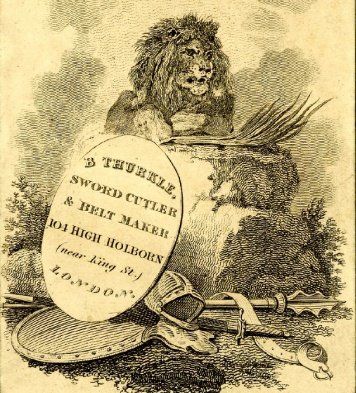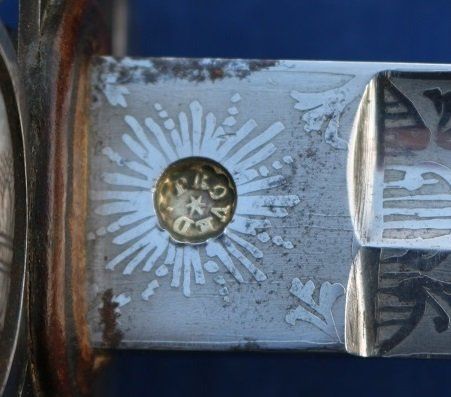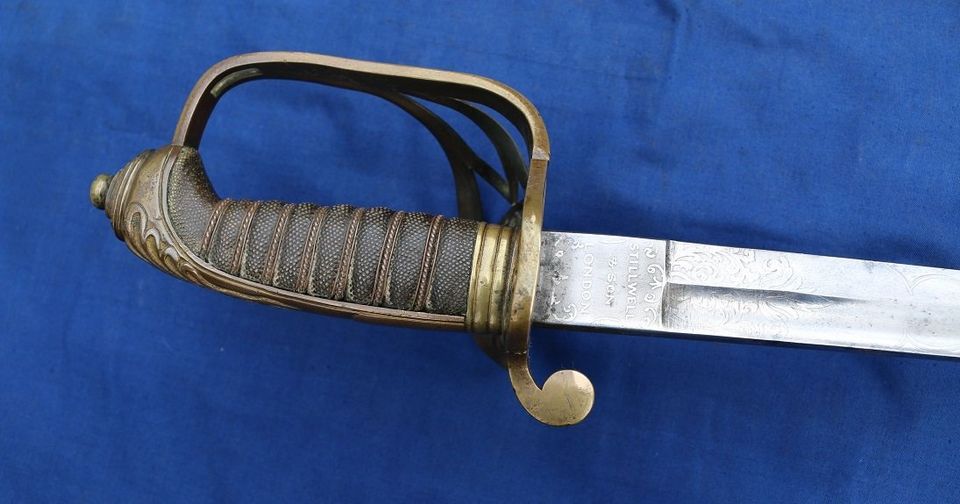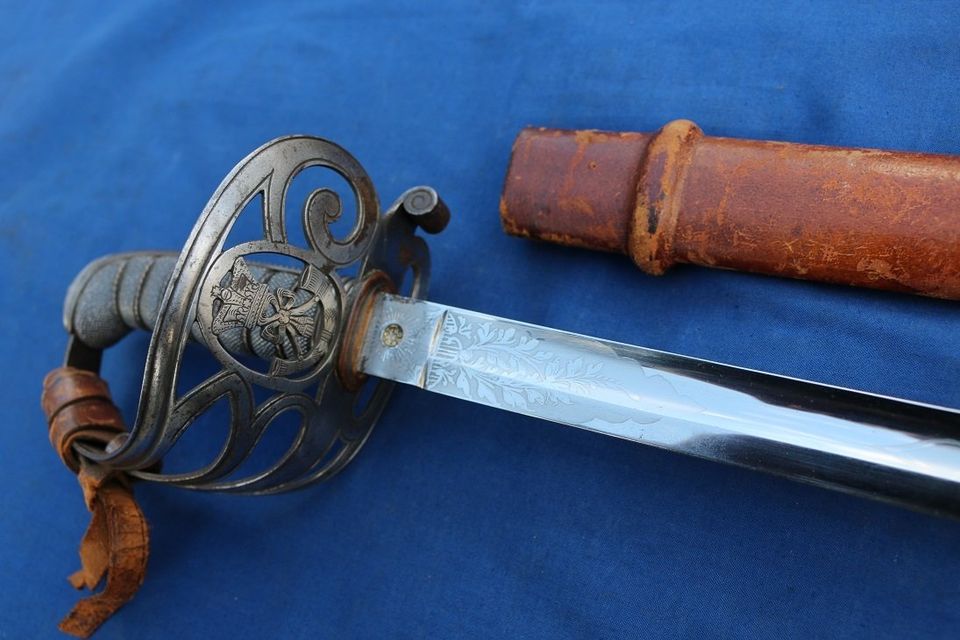Thurkle - A British Sword Making DynastyBy Matt Easton
Thurkle - A British Sword Making Dynasty
By Matt Easton
Some collectors of British military swords will be familiar with the name Thurkle, but relatively few realise how important this family name was in British sword making history. Most collectors can instantly recount all manner of details about Wilkinson, or perhaps even Mole, due to the scales of their businesses and military contracts by the end of the 19th century, but Thurkle's name deserves to be remembered in the same category as a handful of smaller but important makers (such as Reeves and Pillin) who produced more swords than most people realise. The Thurkle family specialised in British officers' swords in the earlier years, but by the later decades of the 19th century the Thurkle name was to be found on officers' swords in the United States of America and on cavalry troopers' sabres in India.
My own introduction to Thurkle's work was with a Rifles officer's sword, pictured above, below in the examples and here, and since sold through Easton Antique Arms, which resided in my collection for a few years. At first sight, this sword was a standard Rifles officer's sword, marked to Benjamin Thurkle, but it had fantastic handling characteristics and very good construction quality. As a fencing instructor myself and a specialist in the military sabre manuals of the mid to late-19th century, this sword felt right in my hand. It is service sharpened and everying is still rock solid on it after 150 years. It is not a fancy sword, but as soon as you hold it you feel that it was made to be used. In keeping with this, the blade was deliberately plain and undecorated, except for the maker's name and address - a feature which we often find associated with specially-ordered fighting swords. This is a sword for a swordsman, not simply a dress accessory.
In the Victorian era there were countless retailers of swords and other military equipment, but very few of these were actually making their own sword blades. The vast majority were purchasing swords, or at least the blades and scabbards, from specialised sword makers and then etching their own name and address onto the ricasso. Some retailers hilted the blades themselves and thus described themselves as 'sword makers', but only a few companies were actually making the blades by the middle of the 19th century. Thurkle was one such maker of blades, along with the likes of Wilkinson, Mole, Reeves, Pillin and a few others. We often find the proof slugs of these makers on swords marked to and retailed by outfitters, but more on the subject of proof slugs below.
The Thurkle sword making family is not well documented now and sadly their company records were reportedly destroyed in a fire in 1912. However, we do know that they were a dynasty of makers who started business in 1749 (according to Benjamin Thurkle's own advertisements, shown below) and they continued until 1897, when they were bought out by the outfitter Gaunt & Sons.
Thanks to the Oldswords.com website and my own researches in period newspapers, combined with the personal records of Robert Wilkinson-Latham, decendent of John Latham (who took over the running of Henry Wilkinson's sword making business in the 1850s), and the research of Peter Walker, both of the latter shared through Swordforum International, we have the following business details about the members of the Thurkle family:
1749-1766: Unknown currently
1766-1790: Francis Thurkle (1st) (Master of the Cutlers' Company in 1766 and 1788/89) - 15 New Street Square, near Fetter Lane, London
1790: Francis Thurkle & Son - 15 New Street Square, near Fetter Lane, London
1791-1801: Francis Thurkle (2nd) (Master of the Cutlers' Company in 1795) - 15 New Street Square, near Fetter Lane, London
1802-1807: George Thurkle - 15 New Street Square, near Fetter Lane, London
1808-1811: Thurkle & Skinner/Skynner - 15 New Street Square, near Fetter Lane, London
1812-1826: George Moses Thurkle (Master of the Cutlers' Company in 1814) - 15 New Street Square, near Fetter Lane, London
1827-1833: Abraham Thurkle - New Street Square & Dean Street, near Fetter Lane, London
1834-1835: Benjamin Thurkle - 238 High Holborn, London
1836-1864: Benjamin Thurkle - 104 High Holborn, London
1864: Edward Thurkle (1st) - 200 High Holborn, London (it seems possible Edward was already at 200 High Holborn and moved to his father's old address at 104 after he died)
1865-1875: Edward Thurkle (1st) - 104 High Holborn, London
1876-1888/9: Edward Thurkle (1st) - 5 Denmark Street, Soho, London
1889-1897: Edward Thurkle & Sons (Edward & George) - 5 Denmark Street, Soho, London
1897: Gaunt & Sons buy out Edward Thurkle & Sons, though George goes on to set up his own business
1907-1912: George Thurkle* - 21 Denmark Place, Charring Cross Road, London
1913-1919: George Thurkle* - 149 High Holborn, London
*George Thurkle seems to have been purchasing swords, or blades, from Wilkinson during this period.
Additional notes from period newspapers:
Thurkle & Skynner
Thurkle and Skynner were listed in 1811 as sword cutlers in New Street Square.
The Public Ledger and Daily Advertiser of 11 February 1811 records:
"Dissolutions of Partnerships:"
"Thurkle & Skynner, New-Street-Square, sword-cutlers."
The Morning Post of 3 December 1813 records:
"Mr. George Thurkle, Sword-Cutler, New Street Square, near Fetter Lane."
George Moses Thurkle
The Stamford Mercury of 21 November 1817, lists G M Thurkle as bankrupt - New Street Square wine merchant and sword cutler, as well as Fleet Street shell-fishmonger.
In various sources of 1817-1822 G M Thurkle is listed at New Street Square, as a wine-merchant and sword cutler, as well as a fishmonger in Fleet Street.
Abraham Thurkle
The Morning Advertiser of 1 December 1831 records:
"Mr. Abraham Thurkle, Sword-Cutler, New Street Square, Fleet Street."
"Under distress for rent."
"Sale of items including "military and naval dress and service swords, Damascus, Andria, Farara [Andrea Ferrara], and other blades, scabbards, brass and steel furnitures for mounting, patterns and moulds for manufacturing, fixtures, implements, and miscellaneous effects."
Benjamin Thurkle
Benjamin (1812-1864) seems to have been the first member of the family to make Thurkle into a bigger business and gain some greater exposure. It is Benjamin, often etched on blades as 'B Thurkle, 104 High Holborn', who first starts to appear with some regularity marked on antique swords from the period. He seems to have been making all manner of swords, from sturdy basic service models right the way up to high status presentation pieces.
From the Volunteer Service Gazette and Military Dispatch, 28 June 1862:
Benjamin Thurkle's trade card - note the "Proved by Powerful Machines" above and below - this was almost certainly in response to Henry Wilkinson's proofing machine and tests, introduced in 1844-45. Other makers, not wanting to be left behind by Wilkinson, quickly instituted their own proofing tests and marked their swords in similar ways. It is clear that some retailers were selling inferior quality blades and marking them as proved anyway (or using softer testing methods), however Thurkle's note of "powerful machinery" used in testing shows that he was keen to live up to the bar which Wilkinson had established. It is very likely that Benjamin Thurkle knew Henry Wilkinson and James Latham (who took over the running of the Wilkinson company) personally.
An unusual sword in the form of a police cutlass/hanger, made by Benjamin Thurkle and with a dedication from him "To his friend T. Harding". The recipient is unidentified currently, but given the style of the sword is seems possible that he was a policeman:
From the Volunteer Service Gazette and Military Dispatch, 4 October 1862, we see that Benjamin was being commissioned to make top-end presentation pieces, putting him in the same category as Wilkinson and Pillin:
Benjamin died in 1864 at the age of 52. From the London Evening Standard of 24 June 1864:
Edward Thurkle & His Sons
The majority of the surviving antique swords marked to Thurkle (or with a Thurkle proof slug - see below) were made under Edward Thurkle senior (lived 1833-1895) or together with his sons Edward and George from 1889, when he added his sons to the company title, until 1897. After 1897 Edward Thurkle's name was used posthumously on swords retailed by Gaunt & Sons, still using the Thurkle proof slug. The proof slug associated with these later years features the T in the centre, as detailed below.
It seems that Edward senior was operating out of a different address in 1864 (when he would have been 31 years old) immediately after his father died, but moved into 104 High Holborn around 1865, presumably after the probate issues of his father Benjamin's death had been resolved. For reasons unknown, he moved the business to a different address in 1876. Edward's two sons, Edward junior (born 1858) and George (born 1863), came into business with him, as noted above.
Below is a fantastic sword by Edward Thurkle, for Lieutenant John Burnard Edwards, 2nd Central Indian Horse, dated to 1881. This particular sword is modelled on the Indian cavalry sabre which had become common for native troopers in the 1870s, but 'officerised' with an etched decorated blade. The sword is now in the collection of the National Army Museum
and this image is copied here with copyright to the NAM - Link here.
Thurkle & Sons (as they named themselves from 1889-1897) are here mentioned in an article about the Armourers and Braziers Exhibition, from the Sheffield Daily Telegraph, 24 May 1890 - It is interesting to note that they had a collection of old arms and armour on display, as well as their contemporary service swords:
A late E Thurkle advertisement (after Edward senior's death in 1895, so presumably for Edward Thurkle junior) in the Army and Navy Gazette from 21 August 1897, the year that Gaunt & Sons seem to have purchased the business. This must have been one of the last Thurkle advertisements before Gaunt absorbed the business:
In 1897 Gaunt & Son purchased Thurkle's business and thereafter used the Thurkle name on swords retailed by themselves.
Gaunt & Sons advert from the Volunteer Service Gazette and Military Dispatch (13 September 1901), listing proved swords for sale as "Edward Thurkle's successors".
Note the "Registered Trade Marks" proof slug images - the top one being associated with Gaunt and the bottom two being Thurkle's:
As we see from the Gaunt & Sons advert above, the proof slugs on British swords at this time (a feature introduced seemingly by Henry Wilkinson in 1845) were sometimes regarded as "Registered Trade Marks". There are two proof slugs which we usually find on swords marked to Thurkle family members and so it is fair to assume that any swords with these proof slugs, but which are not explicitly marked to a Thurkle maker, were probably also made by one of the Thurkles and sold to retailers (who then applied their retailer details in etching). We know that retailers were indeed buying swords from Thurkle and other makers like Mole and Pillin and I find known proof slugs to be a fairly reliable way of identifying the maker of a blade where a known proof slug is used. Unfortunately there were some proof slug designs (such as the fleur de lis) which were used by various makers for trade blades, so it is not always possible to identify the maker of a sword blade from the proof slug.
These are the usual proof slugs found on Thurkle family swords:
The star appears on a lot of swords made in the 1845-1865 period and therefore it seems fair to assume that this was the proof slug adopted by Benjamin Thurkle in 1845 when the proof slug became standard on British officers' swords (there were no proof slugs before that). At this point in time I am not certain whether the star slug went out of use with Benjamin's death in 1864, or whether Edward Thurkle (senior) carried on using it after his death. The swords marked with the later proof slug, with a 'T' in the centre (presumably for 'Thurkle') could date to the 1860s in the earliest examples, but it is not yet clear whether Edward adopted the new 'T' slug straight away or whether this came later. Indeed, it is even possible that Edward Thurkle was using the T proof slug before his father Benjamin died in 1864. Though on balance, based on the surviving swords, it seems that the T proof slug did not come into use until after Benjamin's death. Cross-referencing with more swords, preferably ones which are datable due to the officer's initials or other factors, will hopefully answer these questions in the future. Then the proof slugs could be even more useful for dating purposes.
George Thurkle
George Thurkle (born 1863, son of the older Edward Thurkle and brother of the younger Edward Thurkle, who was 5 years older than George) established his own sword business after Gaunt & Son had bought out Thurkle's main business. However, it seems that he was ordering parts from Wilkinson and others, so it is unclear whether he was actually producing swords himself, or only assembling swords from parts procured elsewhere. George was eventually bought out himself by the Wilkinson Sword Company in 1920. He appears below in 1911 wearing a 16th century style armour (photo courtesy of Robert Wilkinson-Latham):
Antique Examples
Examples of Thurkle swords which have been through Easton Antique Arms, in approximate date order, from about 1850 onwards.
As explained above, the earlier examples with a proof slug showing a star in the middle are probably by Benjamin Thurkle (up to 1864), while the later examples with a T in the middle of the proof slug are probably by Edward Thurkle and his sons, and then Gaunts after that (using the Thurkle name after they bought the business in 1897).
As mentioned, it is not currently clear whether Edward Thurkle immediately started using the T proof slug, or whether he continued using his father's star for a while.
Infantry officer's sword, c. 1845-1860 (I believe from the proof slug to be Benjamin Thurkle's work, retailed by outfitter Stillwell):
Infantry officer's sword, c. 1845-1860:
Rifles officer's sword, c.1845-1864 (marked to Benjamin Thurkle and with a special order plain blade):
Infantry officer's sword, c. 1855-1864:
Rifles officer's sword, c.1860-1875:
Royal Engineers officer's sword, c.1870-1880:
A pre-1892 blade, updated with an 1897 pattern hilt, but with an unusual curved chequered backstrap rather than the usual straight 1895 pattern sort:
Infantry officer's sword with 1845 pattern blade and updated 1895 pattern hilt:
Royal Indian Marines officer's sword, c.1895:
Royal Army Medical Corps officer's sword, c.1905:
A George V example by Gaunt & Son, using the 'late Edward Thurkle' still in WW1:
Copyright Matt Easton, Easton Antique Arms, 2018.
















































